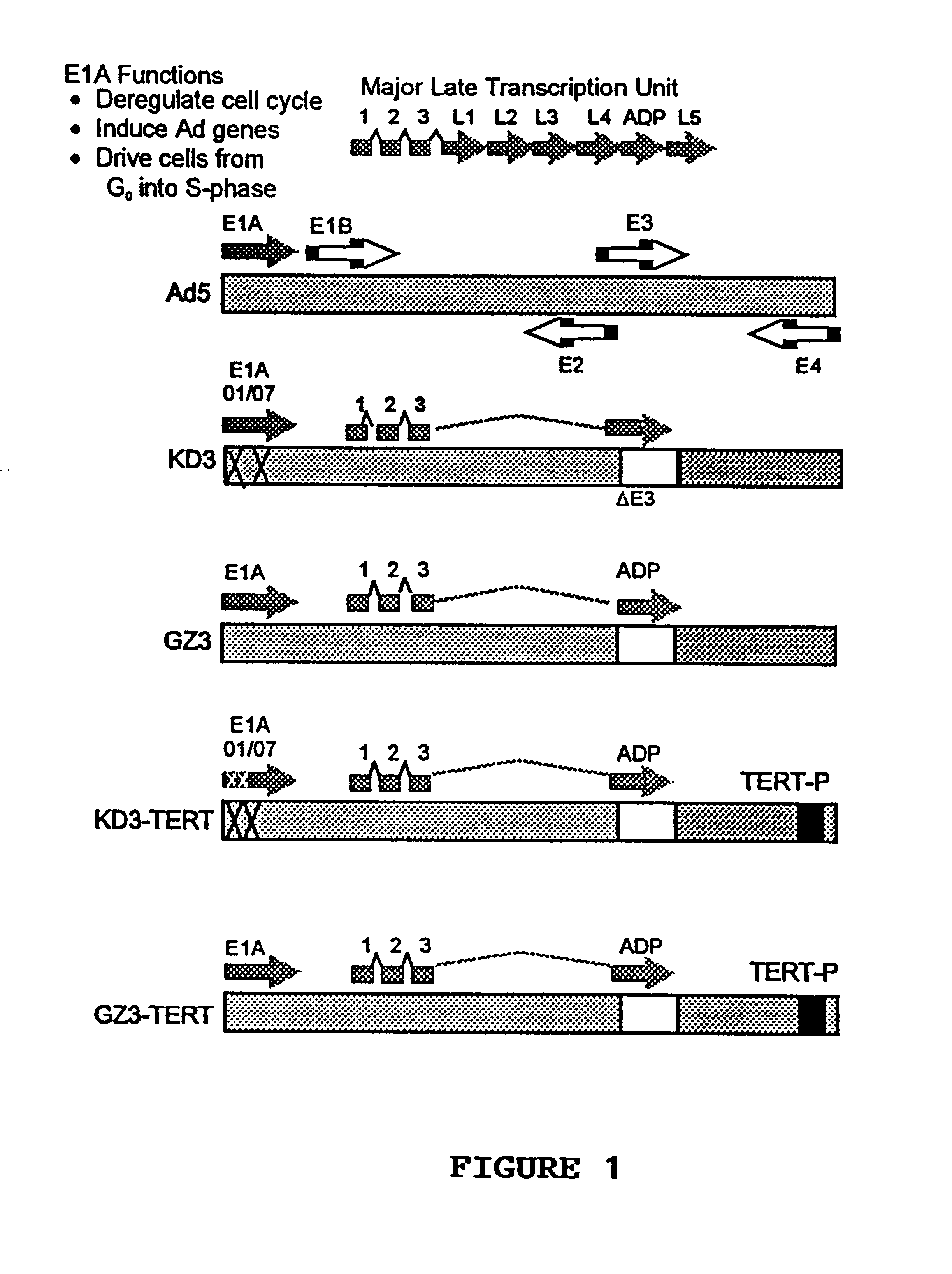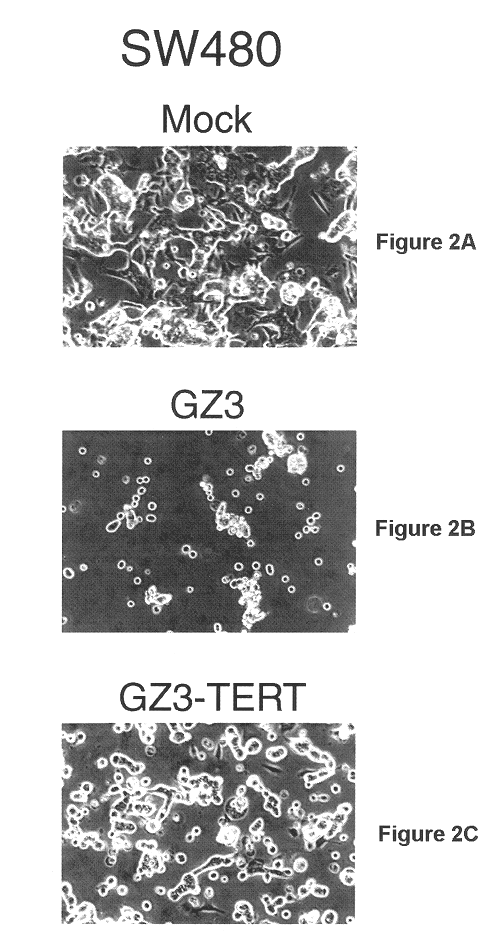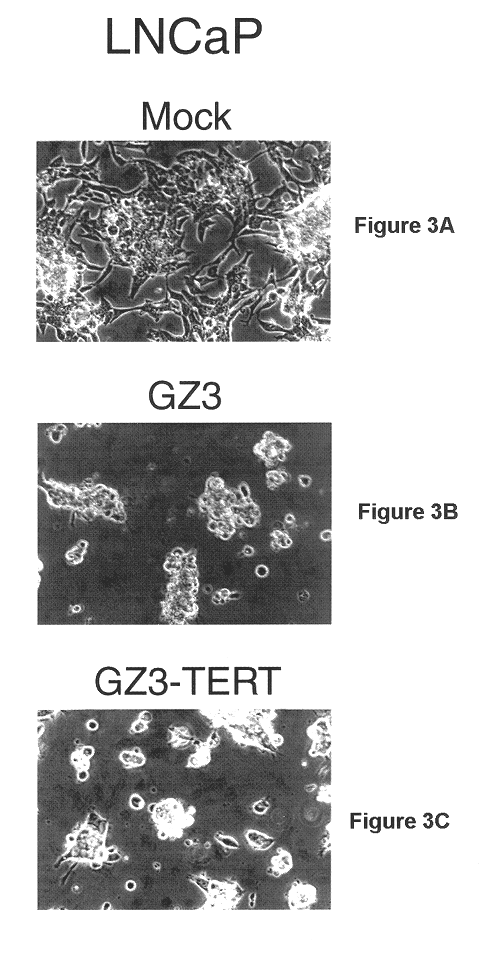Recombinant adenovirus vectors that are replication-competent in tert-expressing cells
a technology of tert-expressing cells and adenoviruses, which is applied in the field of recombinant adenovirus vectors, can solve the problems of inability to replicate vectors, often failing treatment, and not removing all
- Summary
- Abstract
- Description
- Claims
- Application Information
AI Technical Summary
Problems solved by technology
Method used
Image
Examples
example 1
Construction of KD3-TERT and GZ3-TERT.
This example illustrates the construction of GZ3-TERT and KD3-TERT anti-cancer vectors.
First, the inventors used the plasmid pK111 which contains the ADP overexpressing Ad GZ3 genome beginning from a BamHI site (nucleotide number 21256 in Ad5) to the right end of the genome. In pK111, the E4 promoter was deleted using a PCR-based technique, and a BstZ17I restriction site was inserted into the deletion, resulting in the plasmid pdlE4P. The resulting pdlE4P plasmid provides for easy replacement of the Ad E4 promoter with a foreign promoter. This plasmid will be a valuable tool for producing further vectors, where the E4 promoter will be substituted with a tumor specific promoter. Using pdlE4P, a DNA fragment containing the hTERT promoter sequence, flanked by BstZ17I sites (obtained by PCR amplification from human placental cells genomic DNA), was cloned into this newly created restriction site, resulting in plasmid pdlE4TERT. This plasmid was co-t...
example 2
Assays for Cytopathic Effect caused by GZ3-TERT and KD3-TERT.
This example illustrates the ability of GZ3-TERT to replicate within and destroy SW480 adenocarcinoma (colorectal, human) cells.
Various cell lines were grown to about 60-70% confluency in 35 mm Petri dishes. The cells were infected at a multiplicity of 10 pfu / cell with dl309, GZ3 or GZ3-TERT. pfu refers to plaque forming units, i.e. units of infectious vector. The monolayers were visualized by phase contrast microscopy and photographed at certain time points post infection.
The ability of GZ3-TERT to grow within and destroy cancer cells was compared to that of GZ3 and "wild-type" adenovirus by several methods in a variety of human cancer cell lines. As described earlier, and in U.S. application Ser. No. 09 / 351,778, GZ3 has wild type Ad5 E1A and a large deletion in the E3 region that removes the genes for the ADP, gpl9K, RID.alpha., RID.beta., and 14.7K proteins. The adp gene has been reinserted into the E3 region in such a ...
example 3
Assay to Measure Cell Viability After Virus Infection.
The Trypan blue exclusion assay was used to compare the cell destroying effect of GZ3-TERT vs. GZ3 on cancer cells. At the end of the virus replication cycle, cells die and their membranes become porous. Trypan blue enters those cells with a porous cell membrane.
Various cell lines were grown to about 60-70% confluency in 35 mm Petri dishes. Cells growing in monolayers were either mock-infected or infected at a multiplicity of 10 pfu / cell with dl309, GZ3 or GZ3-TERT. Cells were trypsinized at 5 or 10 days post infection, and stained with Trypan blue. Approximately 400 cells were counted in a hemacytometer, and ratios of stained and unstained cells were calculated for each sample.
FIG. 4A shows the percentage of viable cells remaining at 5 and 10 days after LS513 carcinoma (cecum, human) cells were infected with mock (i.e. were mock-infected), dl309, GZ3, or GZ3-TERT. Approximately 62% of the mock-infected cells were viable at 5 day...
PUM
| Property | Measurement | Unit |
|---|---|---|
| time | aaaaa | aaaaa |
| electron microscopy | aaaaa | aaaaa |
| length | aaaaa | aaaaa |
Abstract
Description
Claims
Application Information
 Login to View More
Login to View More - R&D
- Intellectual Property
- Life Sciences
- Materials
- Tech Scout
- Unparalleled Data Quality
- Higher Quality Content
- 60% Fewer Hallucinations
Browse by: Latest US Patents, China's latest patents, Technical Efficacy Thesaurus, Application Domain, Technology Topic, Popular Technical Reports.
© 2025 PatSnap. All rights reserved.Legal|Privacy policy|Modern Slavery Act Transparency Statement|Sitemap|About US| Contact US: help@patsnap.com



